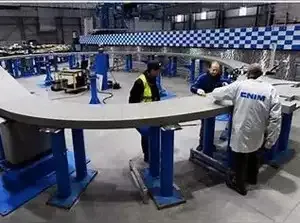A major step forward in nuclear fusion technology, which has the potential to change the way clean, practically free energy is sought, has been achieved in China. The "artificial Sun" Experimental advanced Superconducting Tokamak (EAST) has set a new record of 403 s run time and sustained it for 1,066 s.
Unlike traditional nuclear power stations that employ fission, which atomizes, fusion generates huge quantities of power by bonding atomic nuclei. Inspired by the natural power generation of the Sun, this is a technology that is a highly desired solution to global energy needs, as it does not generate any dangerous radioactive waste or hazardous emissions.
Nuclear fusion is an interesting technology, but there are technical challenges too. Both high temperatures and accurate control over plasma, the gas phase of an atom (ionized), necessary for the fusion reaction to function, are necessary. According to Song Yuntao, deputy director of Hefei Institutes of Physical Science of the Chinese Academy of Sciences (CAS) School,since an actual fusion reactor has to be operated stably and for a long time and so on,the data of this instrument must be precise.
Also Read : 2025 NFL Mock Draft: Shedeur Sanders, Luther Burden III feature in Mel Kiper’s first round picks
These developments provided the reactor with the stability and consistency that allowed it to deliver meaningful insights that could shape the next generation of fusion programs.
Other parts of the world also show advances in the research of fusion. The largest thermonuclear reactor to be built, the International Thermonuclear Experimental Reactor (ITER) in France, is a thermonuclear reactor. The Present completion of the project is further delayed to the 2030s, whereas the "first plasma" goal expected to be met by 2025 has been moved. In order to realize the application of fusion energy, China is investing and contributing about 9% to the development and operation of the ITER.
The Spherical Tokamak for Energy Production (STEP), a fusion effort being led by the United Kingdom, will generate "first plasma" by 2035 and power electricity by the 2040s.
These advances showcase the worldwide consortium to become nuclear fusion leaders. The achievement of China in EAST establishes a superpower status for China in this area and lays the ground for a more clean, green energy era.
Also Read : Spurs vs Pacers NBA Paris Games 2025: January 23 predictions, odds, betting insights
Because of its capability of delivering enormous amounts of energy with no greenhouse gas emission or producing radioactive waste that has the potential to damage, nuclear fusion has the prospect of transforming the way energy is generated. One good clean and renewable energy source to look at for the future is fusion energy, which is essentially impossible to run out of and does not generate any climate pollutants, unlike fossil fuels.
What are the primary barriers to nuclear fusion being a viable technology?
Maintaining a stable plasma state over prolonged timescales at a temperature above 100 million degrees Celsius are just two of the many industrial issues associated with building a commercial nuclear fusion reactor. Nevertheless, energy and/or engineering manpower needed to operate and control the fusion reaction has been identified as a key bottleneck in the realization of the commercialization of fusion.
Budget with ET
India's aviation sector has wings, but airlines can't fly high
Change the game of trade as Trump returns to US throne
Income tax payers' wishlist: More benefits in new tax regime, higher HRA & more
Nuclear fusion is an interesting technology, but there are technical challenges too. Both high temperatures and accurate control over plasma, the gas phase of an atom (ionized), necessary for the fusion reaction to function, are necessary. According to Song Yuntao, deputy director of Hefei Institutes of Physical Science of the Chinese Academy of Sciences (CAS) School,since an actual fusion reactor has to be operated stably and for a long time and so on,the data of this instrument must be precise.
Also Read : 2025 NFL Mock Draft: Shedeur Sanders, Luther Burden III feature in Mel Kiper’s first round picks
These developments provided the reactor with the stability and consistency that allowed it to deliver meaningful insights that could shape the next generation of fusion programs.
Other parts of the world also show advances in the research of fusion. The largest thermonuclear reactor to be built, the International Thermonuclear Experimental Reactor (ITER) in France, is a thermonuclear reactor. The Present completion of the project is further delayed to the 2030s, whereas the "first plasma" goal expected to be met by 2025 has been moved. In order to realize the application of fusion energy, China is investing and contributing about 9% to the development and operation of the ITER.
The Spherical Tokamak for Energy Production (STEP), a fusion effort being led by the United Kingdom, will generate "first plasma" by 2035 and power electricity by the 2040s.
These advances showcase the worldwide consortium to become nuclear fusion leaders. The achievement of China in EAST establishes a superpower status for China in this area and lays the ground for a more clean, green energy era.
Also Read : Spurs vs Pacers NBA Paris Games 2025: January 23 predictions, odds, betting insights
FAQs:
In the energy generation world, what makes nuclear fusion a revolution?Because of its capability of delivering enormous amounts of energy with no greenhouse gas emission or producing radioactive waste that has the potential to damage, nuclear fusion has the prospect of transforming the way energy is generated. One good clean and renewable energy source to look at for the future is fusion energy, which is essentially impossible to run out of and does not generate any climate pollutants, unlike fossil fuels.
What are the primary barriers to nuclear fusion being a viable technology?
Maintaining a stable plasma state over prolonged timescales at a temperature above 100 million degrees Celsius are just two of the many industrial issues associated with building a commercial nuclear fusion reactor. Nevertheless, energy and/or engineering manpower needed to operate and control the fusion reaction has been identified as a key bottleneck in the realization of the commercialization of fusion.
Disclaimer Statement: This content is authored by a 3rd party. The views expressed here are that of the respective authors/ entities and do not represent the views of Economic Times (ET). ET does not guarantee, vouch for or endorse any of its contents nor is responsible for them in any manner whatsoever. Please take all steps necessary to ascertain that any information and content provided is correct, updated, and verified. ET hereby disclaims any and all warranties, express or implied, relating to the report and any content therein.








